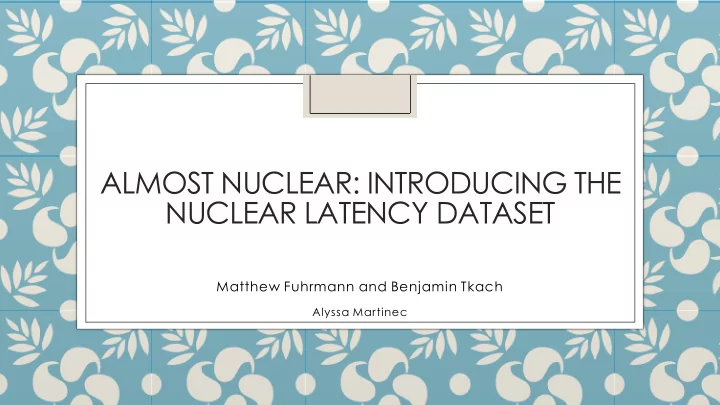

ALMOST NUCLEAR: INTRODUCING THE NUCLEAR LATENCY DATASET Matthew Fuhrmann and Benjamin Tkach Alyssa Martinec
Nuclear Latency ◦ A country having the capacity to quickly produce nuclear weapons in the event of a crisis ◦ Limited scholarly research prior to this article ◦ General questions: How common is nuclear latency? Why do countries develop latent nuclear capabilities? Why do some latent nuclear powers go on to build nuclear weapons, while others are satisfied with just having the technological capacity to make bombs? What are the political effects of nuclear latency? ◦ Research question: Does nuclear latency influence the likelihood of being targeted in military disputes?
Findings ◦ Nuclear latency is about three times more common than proliferation ◦ Preliminary evidence that nuclear latency reduces the likelihood of being targeted in militarized disputes, which suggests similar deterrence benefits of proliferation
Why We Care About Latency ◦ Only 10 countries have nuclear weapons, 31 have latency ◦ Could deter an attack but also cause conflict (i.e. crisis over Iran deal) ◦ Provides political leverage (i.e. Iran has more leverage in the Middle East) ◦ Could instigate proliferation due to spread of nuclear technology
Nuclear Latency (NL) dataset ◦ Previous literature fails to clearly define latency, uses old data and ‘‘surrogate indicators’’ ◦ NL dataset presented as a time series, provides information on the global spread of latent nuclear capabilities from 1939 to 2012 ◦ Focuses on the development of enrichment and reprocessing (ENR) facilities ◦ Contains 241 ENR facilities with information on the operational history, size, purpose (whether it served civilian or military functions), and whether it is multinational
Nuclear Latency (NL) dataset cont’ ◦ Reveals whether facilities were subjected to safeguards administered by the IAEA and whether they were built covertly or with foreign assistance ◦ Allows researchers to account for variation when measuring nuclear latency (one ENR facility vs a dozen, small amounts of plutonium on a laboratory scale or large amounts) ◦ Fuhrman and Tkach only provide one empirical application, which shows how the study of nuclear latency can contribute to our understanding of international conflict dynamics
Empirical Application for International Conflict Dynamics ◦ Built on an existing study that examines the relationship between nuclear weapons and military conflict (Gartzke and Jo, 2009) ◦ Uses a standard time-series cross-sectional dataset that covers the period from 1945 to 2000, the unit of observation is the directed-dyad-year ◦ The dependent variable comes from the Correlates of War Militarized Interstate Dispute dataset (Ghosn et al., 2004) MID Initiation is coded 1 if the potential challenger initiates a militarized dispute against the target and 0 otherwise ◦ Primary independent variable of interest (Nuclear Latency B) measures whether the potential target in a militarized dispute has latent nuclear capabilities in a given year, coded 1 or 0 ◦ Latency status of the challenger (Nuclear Latency A) is also measured
Theoretical Expectations ◦ Hypothesis 1: Having nuclear latency reduces the likelihood of being targeted in a militarized interstate dispute. ◦ Hypothesis 1A: Having nuclear latency increases the likelihood of being targeted in a militarized interstate dispute.
◦ Model 1 is a replica of Gartzke and Jo’s (2009) model ◦ Model 2 adds the variables Nuclear Latency A and Nuclear Latency B. ◦ The coefficient on Nuclear Latency B is negative and statistically significant, indicating that nuclear latency is associated with a lower risk of being targeted in military disputes ◦ Model 3 adds variables that measure whether the challenger and target have active bomb programs (Nuclear Weapons Pursuit A and Nuclear Weapons Pursuit B), no important change
Shortcomings ◦ Does not examine how varying degrees of nuclear latency may influence international conflict dynamics ◦ Does not explore why latency appears to reduce the risk of being targeted in military disputes ◦ If a country without a research reactor in operation has ENR facilities, its ENR activity would not be included in the NL dataset (very unlikely to actually occur) ◦ Cannot be certain that dataset contains all ENR plants, since some facilities may remain covert
INTRODUCING NU-CLEAR: A LATENT VARIABLE APPROACH TO MEASURING NUCLEAR PROFICIENCY Bradley C. Smith and William Spaniel Alyssa Martinec
Problem with Previous Research ◦ Researchers tend to use observable characteristics as a proxy for nuclear latency ◦ Implicitly assumes that each indicator is equally informative and that measurement error is not a concern ◦ Nu-CLEAR applies a statistical measurement model to directly estimate nuclear proficiency from observed indicators ◦ Finds that weapons exploration, reprocessing, and power plants are relatively noisy indicators of nuclear capacity
How it Works ◦ Weights each nuclear-related activity appropriately ◦ Acknowledges some activities may be noisier indicators of nuclear proficiency than others, independent of their technical difficulty ◦ Treats unobservable factors as latent traits and learns about them using appropriate statistical models of observed actions ◦ Specifically, Nu-CLEAR adopts a latent-variable model grounded in item-response theory (IRT) and takes a Bayesian approach to estimation ◦ IRT uses the responses of individuals to “items” to recover estimates of unobservable quantities of interest (i.e. a legislator’s voting record reveals information about their ideological preferences, a state’s performance on activities related to nuclear production provides information about their underlying nuclear proficiency)
Shortcomings ◦ Does not explicitly account for dynamics in the estimation procedure or model potential dependence among activities ◦ “Let the data speak,” while objectively superior to avoid bias, is more inaccessible to policymakers and others outside of academia who do not know how to read data
Recommend
More recommend